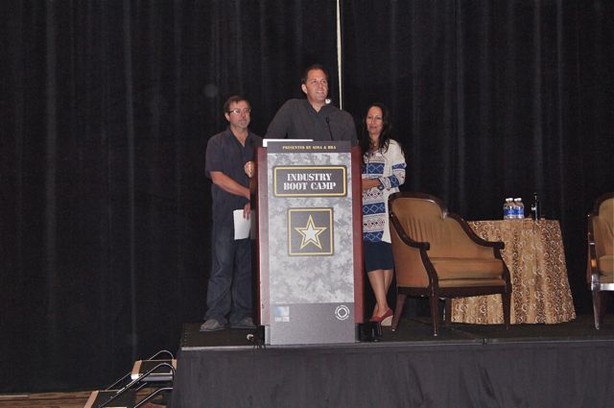SIMA and the BRA hosted a full day Industry Boot Camp yesterday at the Hyatt in Huntington Beach. About 135 people attended the gathering.
Here are some highlights from the day. See our slide show, above, for photos from the event.
Keynote with Rip Curl USA CEO Kelly Gibson
Kelly Gibson kicked off the event with his thoughts on the state of the industry and filled the crowd in on Rip Curl today and a bit of his own background.
Kelly, a former pro surfer, came over to Rip Curl five years ago. Prior to Rip Curl, he was President and CEO for O’Neill.
 Kelly Gibson of Rip Curl and Sean Smith of SIMA
Kelly Gibson of Rip Curl and Sean Smith of SIMAWhile there are a lot of brands in the action sports industry trying to touch on multiple disciplines, he said Rip Curl aims to be the ultimate surf company.
Before coming on board, there had been some mismanagement issues and Kelly has been working hard to help the company gain market share in the U.S.
One of the first things he did after rebuilding his own team was create new design hubs. Since trends in Australia (where Rip Curl is based) move much faster than in the U.S., there are now three separate design hubs for the brand: one in Australia, one in Europe, and one in the U.S.
He’s also been focusing on product innovations, especially wetsuits and boardshorts.
As for the state of the industry, he thinks it has never been better.
“People may laugh, but I think we are the strongest we have ever been. The true surf enthusiasts — there has never been more people in the water,” he said.
“What we lost … maybe some revenues have gone, but I think we were getting phony sales from that secondary customer buying surf and skate that are now buying MMA brands. For the customer to move that fast, it means they were never ours to begin with anyway.”
He also said that performance in actual surfing has increased faster than ever before, forcing brands to innovate.
As for Rip Curl expanding their own retail footprint, Kelly said they are lucky in that the company is still privately owned and that means they don’t always have to think about next quarter, but rather focus on what’s best for the brand now.
Retail-wise, they are continuing to focus on their core partners.
See Page 2 for a summary of the State of the Industry panel with Michael Tomson
State of the Industry with Michael Tomson
Michael Tomson, former pro surfer and Gotcha founder, helped moderate a panel with Nick Cocores of Thalia Street Surf Shop, Bruce Cromartie who runs BC Surf and Sport, Mark Price who runs Firewire Surfboards and Charlie Setzler who runs Rusty.
The panelists spoke about taking risks at retail, the importance of brand innovation, segmentation strategies and how to survive in the surf industry given the current conditions.
With brands like Nike coming in with massive marketing dollars and retailers like Hollister continuing to do well, risk is necessary.
 Michael Tomson leads the state of the industry panel with (L to R) Mark Price, Bruce Cromartie, Nick Cocores and Charlie Setzler.
Michael Tomson leads the state of the industry panel with (L to R) Mark Price, Bruce Cromartie, Nick Cocores and Charlie Setzler.Thalia Street Surf Shop is a good example of a smaller shop that has had success in Orange County, and who has taken huge risks by carrying littler brands, “weird” products like shorter boardshorts, and eschewing carrying products from major brands like O’Neill, Hurley, Quiksilver, Billabong and Volcom.
Because Thalia has a specific vision and takes a lot of risks, Michael said the shop should be a model for others to be inspired by.
He said that Thalia Street Surf Shop is also interesting because they opened a partner store with Vans just last year. Thalia runs the store, but Vans helps with merchandising and fills the shop with their core line. Michael said he sees partnerships like the Vans/Thalia store a sign of the times, but also sees more brands segmenting their lines.
While Vans carries a full range of core items for shops like Thalia, they also make an entire line of items they sell to stores like JC Penny’s.
Rusty has taken a similar approach, also opening JC Penny’s with a completely different logo and line then what they sell their core customers.
Michael alluded to Ralph Lauren, one of the first apparel companies to successfully segment its line.
Adding Chaps at midtier only made their whole brand that much stronger, but mostly because Ralph Lauren as a brand has managed its segmentation strategy and taken control of its own brand properly.
Charlie Setzler said Rusty has had success segmenting its line because they treat each customer completely different.
Brand Innovation
Besides segmenting lines for certain customers, there was a lot of talk about brands needing to innovate to stay ahead and to give customers a reason to buy products at retail.
With companies like Nike who have significant marketing funds, Michael said creativity and innovation will be key for brands to survive in the future.
Retailer Risks
Besides brands, retailers also need to take risks. While core retailers continue to want items faster and at better terms, they need to share risks for the industry to thrive, especially when buying newer and/or innovative products and brands.
One retailer mentioned that buying Go Pro cameras and Toms shoes were extremely risky purchases at the time, though have had incredible sell throughs.
For the industry to thrive, everyone is going to have to take some risks.
“The minute we go safe we are dead in the water,” said Mark Price.
“Our consumer demands newness and creativity, and if it doesn’t come from us, someone else will step in.”






